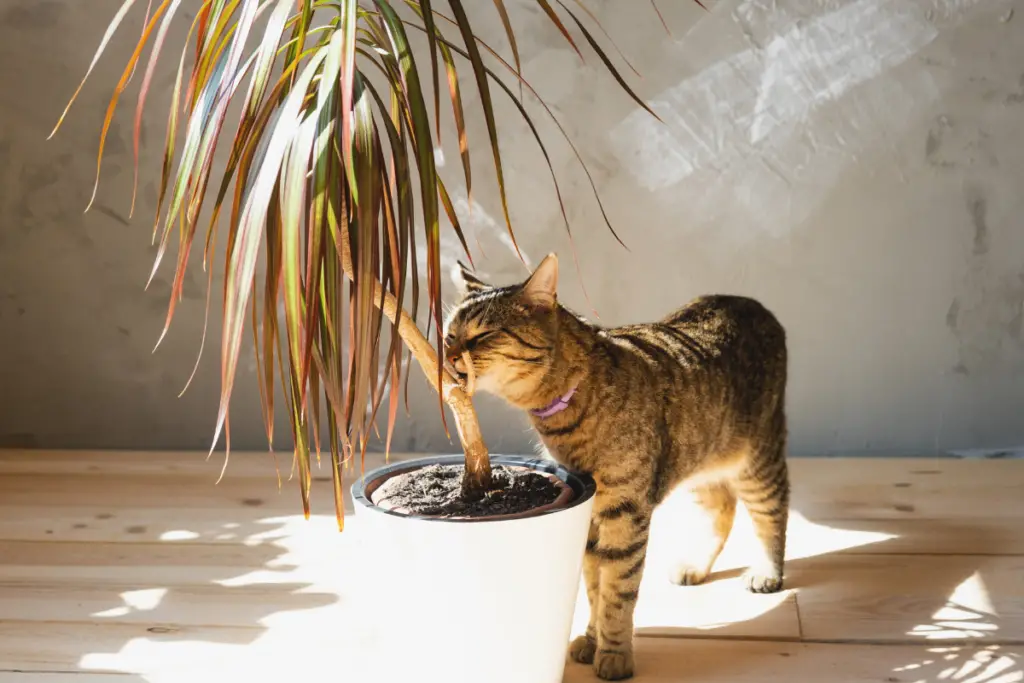Dracaena plants are a popular choice for indoor decoration, thanks to their attractive foliage and ease of care.
However, many pet owners are concerned about whether these plants are safe for their furry friends.
In particular, the question of whether Dracaena plants are toxic to cats is a common one.
According to multiple sources, including the American Society for the Prevention of Cruelty to Animals (ASPCA), Dracaena plants are indeed toxic to cats.
The plants contain a chemical compound called saponin, which is part of a larger family of toxic compounds.
If a cat chews on or ingests any part of a Dracaena plant, they may experience a range of symptoms, including vomiting, diarrhea, loss of appetite, dilated pupils, increased heart rate, weakness, drooling, depression, and dehydration. In severe cases, ingestion of Dracaena plants can be fatal to cats.
Given the potential risks, it is important for cat owners to take precautions if they have Dracaena plants in their homes.
This may include keeping the plants out of reach of cats, or choosing alternative houseplants that are not toxic to felines.

Table of Contents
Understanding Dracaena Plants
Dracaena is a genus of plants that are popular as houseplants due to their attractive foliage and ease of care.
These plants are native to Africa and Asia and belong to the family Asparagaceae. There are over 120 species of Dracaena, and they come in a variety of sizes and shapes, ranging from small tabletop plants to large trees.
The leaves of Dracaena plants are long and narrow, and they can be either solid green or variegated with white, cream, or yellow stripes.
The plants produce small, fragrant flowers that are usually white or cream-colored, but they are unlikely to bloom when grown indoors.
While Dracaena plants are generally safe for humans, they can be toxic to cats and dogs. The plant contains a chemical compound called saponin, which is part of a large family of toxic compounds.
If a cat chews on or eats the leaves of a Dracaena plant, they may experience a range of symptoms, including vomiting, diarrhea, loss of appetite, dilated pupils, increased heart rate, weakness, drooling, depression, and dehydration.
It’s important to note that not all Dracaena species are equally toxic to cats. Some species, such as Dracaena marginata, are more toxic than others.
If you have cats in your home and you want to keep Dracaena plants, it’s best to choose a species that is less toxic or keep the plants out of reach of your pets.
In summary, Dracaena plants are a popular choice for indoor plants due to their attractive foliage and ease of care. However, they can be toxic to cats and dogs due to the presence of saponin in their leaves.
If you have cats in your home, it’s best to choose a less toxic species of Dracaena or keep the plants out of reach of your pets.
Are Dracaena Plants Toxic To Cats?
Dracaena plants are popular indoor plants that are known for their attractive foliage and ease of care. However, pet owners need to be aware that these plants are toxic to cats and dogs.
In this section, we will focus on the toxicity of Dracaena plants to cats.
The toxic compound in Dracaena plants is saponin, which is found in the leaves of the plant. If a cat chews on or ingests any part of the Dracaena plant, it can lead to a range of symptoms.
These symptoms include vomiting, diarrhea, loss of appetite, dilated pupils, increased heart rate, weakness, drooling, depression, and dehydration.
According to the American Society for the Prevention of Cruelty to Animals (ASPCA), Dracaena plants are toxic to cats and can cause vomiting (occasionally with blood), depression, anorexia, hypersalivation, and dilated pupils.
The severity of the symptoms will depend on the amount of the plant ingested and the individual cat’s sensitivity to the toxin.
It is essential to keep Dracaena plants out of the reach of cats, especially if the cat is known to chew on plants.
Pet owners can also consider alternative pet-safe indoor plants such as spider plants, bamboo plants, or African violets.
If a cat ingests any part of the Dracaena plant, it is recommended to seek veterinary attention immediately.
Effects of Dracaena Poisoning in Cats
Dracaena plants contain saponins, a toxic compound that can cause harmful effects on cats when ingested.
The severity of the symptoms may depend on the amount of the plant that the cat has consumed.
Some common symptoms of dracaena poisoning in cats include:
- Vomiting (sometimes with blood)
- Diarrhea
- Loss of appetite
- Dilated pupils
- Increased heart rate
- Weakness
- Drooling
- Depression
- Dehydration
Cats that have ingested a large amount of dracaena may experience more severe symptoms, such as seizures or difficulty breathing.
If you suspect that your cat has consumed dracaena, it is crucial to seek veterinary care immediately.
The toxic effects of dracaena poisoning can last for several days, and in severe cases, it can be fatal.
Therefore, it is essential to keep dracaena plants out of reach of cats and other pets.
If you have a cat that has ingested dracaena, it is essential to provide supportive care, such as fluids, anti-nausea medication, and electrolyte replacement. In severe cases, hospitalization may be necessary.
Overall, dracaena plants are toxic to cats and can cause severe symptoms when ingested.
Therefore, it is crucial to keep these plants out of reach of cats and other pets to prevent accidental ingestion.
Symptoms of Dracaena Poisoning in Cats
Dracaena plants are toxic to cats and can cause a range of symptoms if ingested.
The severity of the symptoms can vary depending on the amount of plant material consumed and the size of the cat.
The following are some common symptoms of dracaena poisoning in cats:
- Vomiting: Cats may vomit after ingesting dracaena leaves. The vomit may contain plant material or blood.
- Loss of appetite: Cats may lose their appetite and refuse to eat or drink.
- Dilated pupils: Cats’ pupils may become dilated after ingesting dracaena.
- Increased heart rate: Cats’ heart rate may increase after ingesting dracaena.
- Weakness: Cats may become weak after ingesting dracaena.
- Drooling: Cats may drool excessively after ingesting dracaena.
- Depression: Cats may become depressed and lethargic after ingesting dracaena.
- Dehydration: In severe cases, cats may become dehydrated due to vomiting and diarrhea.
If a cat shows any of these symptoms after ingesting dracaena, it is important to contact a veterinarian immediately.
Dracaena poisoning can quickly lead to severe dehydration and complications if left untreated.
In some cases, owners may not realize that their cat has ingested dracaena until symptoms appear.
Therefore, it is important to keep dracaena plants out of reach of cats and to monitor cats closely if they are exposed to the plants.
Treatment for Dracaena Poisoning in Cats
If a cat has ingested any part of a Dracaena plant, it is important to seek veterinary care immediately.
The severity of the symptoms will vary depending on the amount ingested and the size of the cat.
The first step in treatment is to induce vomiting to remove any remaining plant material from the stomach.
This can be done by administering a solution of hydrogen peroxide or by using an emetic medication. However, inducing vomiting is not recommended if the cat is already exhibiting signs of depression or seizures.
Activated charcoal may also be given to help absorb any remaining toxins in the digestive system.
In severe cases, hospitalization may be necessary to provide supportive care such as IV fluids and medications to control vomiting and seizures.
It is important to note that there is no specific antidote for Dracaena poisoning. Treatment is primarily supportive and focused on managing symptoms until the cat has fully recovered.
Owners should also take steps to prevent further exposure to Dracaena plants by removing them from the home or keeping them out of reach of pets.
If a cat is known to be a plant chewer, it is best to avoid keeping any toxic plants in the home altogether.
In conclusion, Dracaena plants are toxic to cats and can cause serious health issues if ingested. If a cat has consumed any part of a Dracaena plant, seeking veterinary care immediately is crucial.
Treatment is focused on managing symptoms and providing supportive care until the cat has fully recovered. Owners should take preventative measures to avoid further exposure to toxic plants.
Preventing Dracaena Poisoning in Cats
To prevent Dracaena poisoning in cats, it is important to keep these plants out of their reach. This can be done by placing them in areas where cats cannot access them, such as high shelves or hanging baskets.
Alternatively, pet owners can choose to not have these plants in their homes if they have cats.
It is also important to be aware of the signs of poisoning in cats. If a cat has ingested any part of a Dracaena plant, they may exhibit symptoms such as vomiting, diarrhea, loss of appetite, dilated pupils, increased heart rate, weakness, drooling, depression, and dehydration.
If any of these symptoms are observed, pet owners should contact their veterinarian immediately.
Pet owners should also consider having the ASPCA Animal Poison Control Center (APCC) phone number on hand in case of emergencies.
The APCC can provide guidance and assistance for pet owners who suspect their pets have ingested toxic substances, including Dracaena plants. The phone number for the APCC is (888) 426-4435.
In addition, pet owners should be mindful of other toxic plants that may be present in their homes or yards.
Some common toxic plants include lilies, azaleas, and tulips. It is important to research any plant before bringing it into a home with pets to ensure it is safe for them.
Overall, preventing Dracaena poisoning in cats involves being aware of the risks and taking steps to mitigate them.
By keeping these plants out of reach, knowing the signs of poisoning, and having resources available in case of emergencies, pet owners can help keep their cats safe and healthy.
Alternatives to Dracaena Plants for Cat Owners
For cat owners who want to avoid the potential dangers of Dracaena plants, there are several alternative houseplants that are considered cat-friendly.
Here are some options:
Spider Plant
Spider plants are known for their air-purifying qualities and are considered non-toxic to cats. They are easy to care for and can be grown in a variety of conditions.
These plants are also known for their ability to produce “spiderettes,” or small offshoots that can be propagated and grown into new plants.
Boston Fern
Boston ferns are another popular houseplant that is safe for cats. They are known for their lush foliage and can be grown in a variety of lighting conditions.
It is important to note that while Boston ferns are not toxic to cats, they can be harmful if ingested in large quantities, as they can cause stomach upset.
African Violet
African violets are a popular flowering houseplant that is safe for cats. They are known for their beautiful blooms and can be grown in a variety of lighting conditions.
African violets prefer slightly moist soil and should be watered from the bottom to avoid getting water on their leaves.
Bamboo Palm
Bamboo palms are a popular houseplant that is considered non-toxic to cats. They are known for their ability to purify the air and can grow up to 12 feet tall.
Bamboo palms prefer bright, indirect light and should be watered when the top inch of soil feels dry to the touch.
Catnip
For cat owners who want to provide their feline friends with a plant of their own, catnip is a great option.
Catnip is a member of the mint family and is known for its ability to induce a euphoric state in cats. It is safe for cats to eat and can be grown indoors or outdoors.
Overall, there are many cat-friendly houseplants that can be grown indoors. By choosing the right plants, cat owners can create a safe and healthy environment for their furry friends.
conclusion
In conclusion, Dracaena plants are indeed toxic to cats and can cause a range of symptoms including vomiting, diarrhea, and even kidney failure in severe cases.
Therefore, it is important to keep these plants out of reach of your feline friends or opt for pet-friendly alternatives to keep your home both beautiful and safe.
- How to Dry Basil Leaves: A Professional Guide
- Is an Avocado a Fruit or Vegetable? Simple Answer and Explanation
- Does Pineapple Have Seeds? Exploring the Anatomy of Pineapples
- Blooming Through Winter: Can I Grow Vegetables Indoors in the Winter?
- What Can You Grow in a Greenhouse All Year Round: A Guide to Year-Round Greenhouse Gardening
- Are Blueberries Blue? Debunking the Myth of Their Color
















